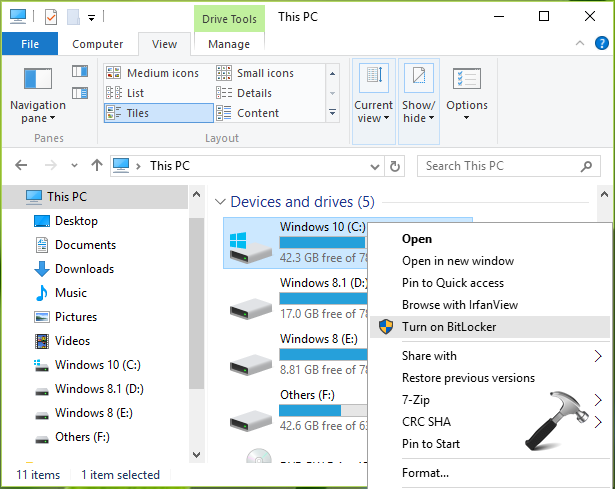
- TPM TRUSTED PLATFORM MODULE WINDOWS 10 HOW TO
- TPM TRUSTED PLATFORM MODULE WINDOWS 10 INSTALL
- TPM TRUSTED PLATFORM MODULE WINDOWS 10 UPDATE
- TPM TRUSTED PLATFORM MODULE WINDOWS 10 UPGRADE
- TPM TRUSTED PLATFORM MODULE WINDOWS 10 WINDOWS 10
That’s done by going into your Windows machine and shutting it down (Start Menu > Power > Shut Down). You can test it for yourself, but the Trusted Platform Module can’t be installed on your virtual machine until you encrypt your VM.
TPM TRUSTED PLATFORM MODULE WINDOWS 10 INSTALL
The wrinkle here is that you can’t just install the TPM 2.0 module on your virtual machine: You have to encrypt your virtual machine first… ENCRYPT VIRTUAL MACHINE IN VMWARE FUSIONįortunately, both the encryption and TPM install steps are easy if you know what order they need to happen.
TPM TRUSTED PLATFORM MODULE WINDOWS 10 WINDOWS 10
Run the compatibility checker on your Windows 10 virtual machine in VMware Fusion and you’ll undoubtedly get this result: Hopefully, Microsoft has re-enabled the PC Health Check app download too: As I write this, it no longer shows up at the indicated link, but it worked fine 48 hours ago. Start out by reading through my Check to See If Your PC is Windows 11 Compatible tutorial. But on a virtual machine? It’s a quick download and install, as it happens, and you can indeed make your Windows 10 virtual machine Windows 11 ready, as I’ll demonstrate. Not just that, but you need version 2.0 of the physical hardware chip on your computer, so it’s not an app you can install on your PC. Indeed, most of the Windows tutorials on this site in my PC Help area were produced with the help of my trusty VMware Fusion virtual Win10 system.Īs many have written about, the early versions of Microsoft Windows 11 require something called a Trusted Platform Module, or TPM. Whether you choose a dual boot scenario or just run Windows within a virtual machine through either Parallels or VMware Fusion, it’s surprisingly fast and compatible.
TPM TRUSTED PLATFORM MODULE WINDOWS 10 HOW TO
If you are unsure how to make any needed changes to the TPM settings, we recommend that you check your PC manufacturer’s support information or contact their support organization.Developers have long since realized that one of the great features of a modern Mac system is that it can also run Windows really well. The option to enable the TPM may be labeled Security Device, Security Device Support, TPM State, AMD fTPM switch, AMD PSP fTPM, Intel PTT, or Intel Platform Trust Technology.

These settings are sometimes contained in a sub-menu in the UEFI BIOS labeled Advanced, Security, or Trusted Computing.
TPM TRUSTED PLATFORM MODULE WINDOWS 10 UPDATE
You can access these settings by choosing: Settings > Update & Security > Recovery > Restart now.įrom the next screen, choose Troubleshoot > Advanced options > UEFI Firmware Settings > Restart to make the changes. If you need to enable TPM, these settings are managed via the UEFI BIOS (PC firmware) and vary based on your device. If it is less than 2.0 your device does not meet the Windows 11 requirement. If you see a message confirming TPM is ready to use, check Specification Version under TPM Manufacturer Information to verify it is 2.0. If you are able to enable the TPM, complete the next step to verify that it is a TPM 2.0. See How to enable TPM for more information or check your PC manufacturer’s support information for instructions to enable the TPM. If you see a message saying a “Compatible TPM cannot be found,” your PC may have a TPM that is disabled. Type “tpm.msc” (do not use quotation marks) and choose OK. Option 2: Use the Microsoft Management Console If it is less than 2.0, your device does not meet the Windows 11 requirements. If you see an option for Security processor details under Security processor, select that and verify that your Specification version is 2.0.

If you are able to enable a TPM, complete the next step to verify that it is a TPM 2.0. see How to enable TPM for more information or check your PC manufacturer’s support information for instructions. If you do not see a Security processor section on this screen your PC may have a TPM that is disabled. Run Settings > Update & Security > Windows Security > Device Security Most retail PC motherboards used by people building their own PC, for example, ship with TPM turned off by default even though it is almost always available to be enabled. If you are considering upgrading to Windows 11, check to ensure TPM 2.0 is enabled on your device. In some cases, PCs that are capable of running TPM 2.0 are not set up to do so. TPM 2.0 is used in Windows 11 for a number of features, including Windows Hello for identity protection and BitLocker for data protection. TPM 2.0 is required to run Windows 11, as an important building block for security-related features. Most PCs that have shipped in the last 5 years are capable of running Trusted Platform Module version 2.0 (TPM 2.0). If you are unfamiliar with this level of technical detail, we recommend that you consult your PC manufacturer’s support information for more instructions specific to your device.
TPM TRUSTED PLATFORM MODULE WINDOWS 10 UPGRADE
This article is intended for users who are not able to upgrade to Windows 11 because their PC is not currently enabled with TPM 2.0 or their PC is capable of running TPM 2.0 but is not set up to do so.


 0 kommentar(er)
0 kommentar(er)
